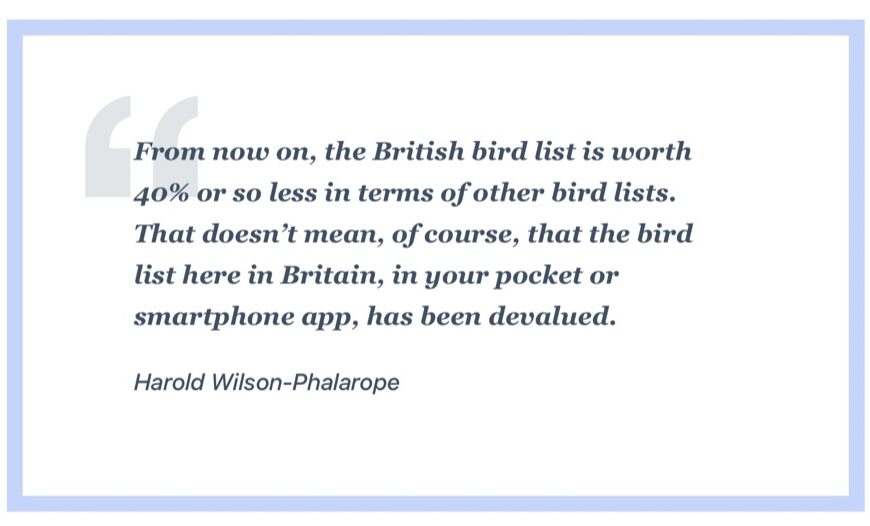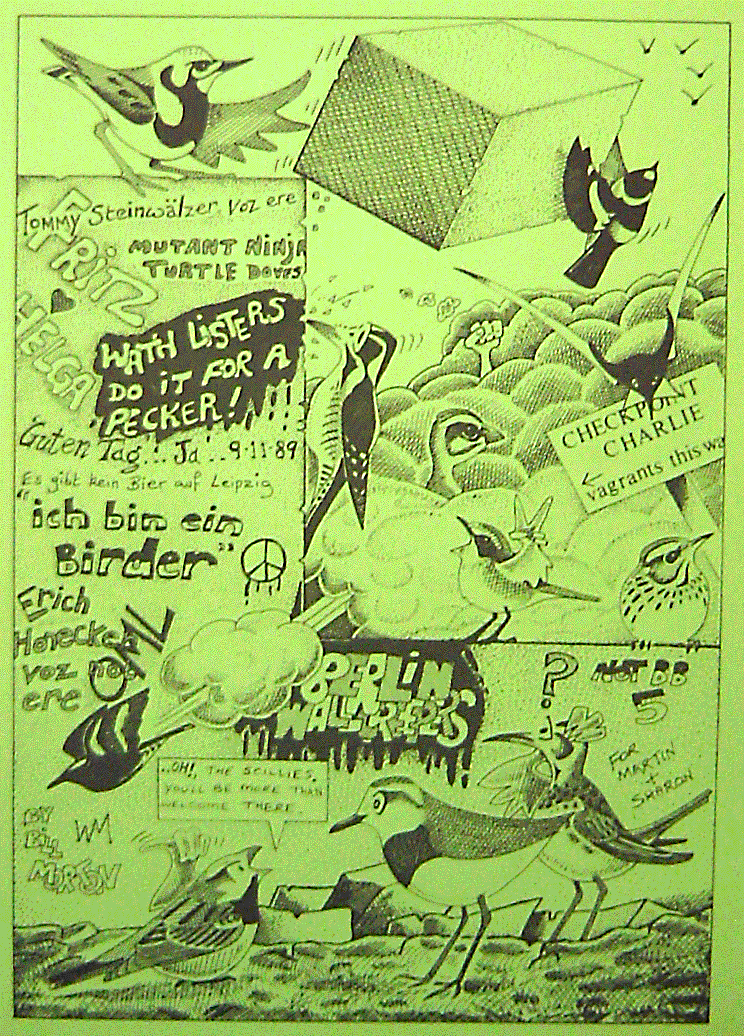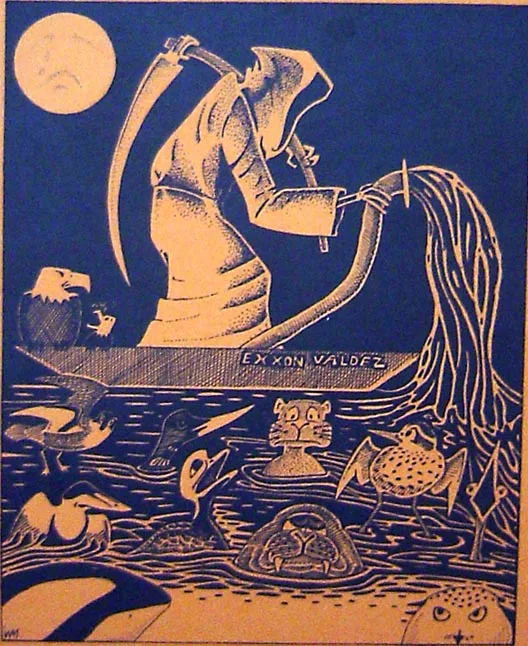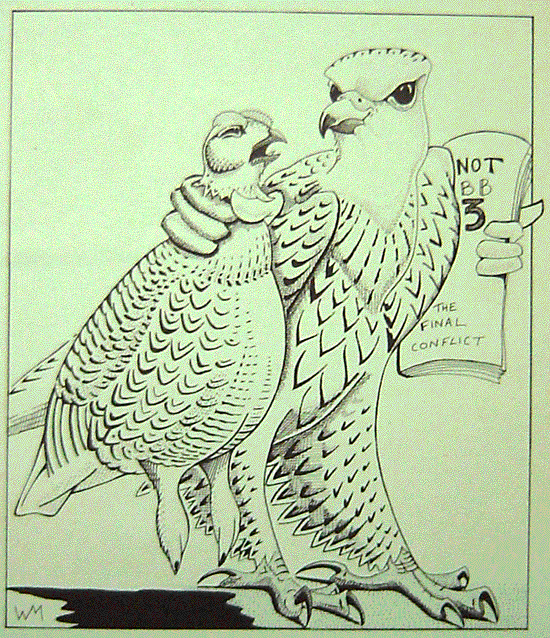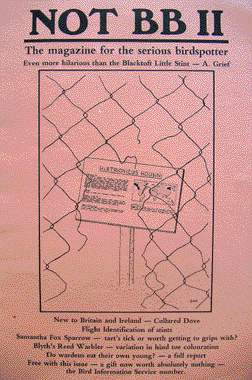What a great pleasure this is, to invite myself to introduce the welcome rerun (Surely, totally unnecessary rehashing – ED) of Not BB, and to have this chance to reminisce about its rise and fall, which surely represented a golden era in British birding comedy. As my old friend Steve Hassles Holloway would say, “Halycon days.”
While we planned our second trip to Beidaihe in China, Simon Stirrup, Dan Duff and I used to drive up to the Norfolk coast and chat about British Birds’ penchant for letters about corpse-eating Turnstones, and articles like the renowned Toyland Story. What a lark it would be, we thought, to produce something wry, almost as wry as Private Eye was wry.
Of course, back in those days you could still get bread pudding at NancyBoy’s, where you were often interrupted by the ringing of the nation’s birdline. Those were indeed halycon times, when you took bird photos using proper cameras loaded with real, grainy film, A Man Called Roy was almost reinventing the grapevine, I had to wrestle with my scope just to open the thing. As I sat in my student house on warm evenings, typing Not BB on a friend’s Amstrad, I (get on with it! – ED)
(Read on for Vol 1.)
Not BB, Volume 1
The magazine for the serious birdspotter
“The funniest thing since the Fair Isle Sanderling” – Lars Jensen
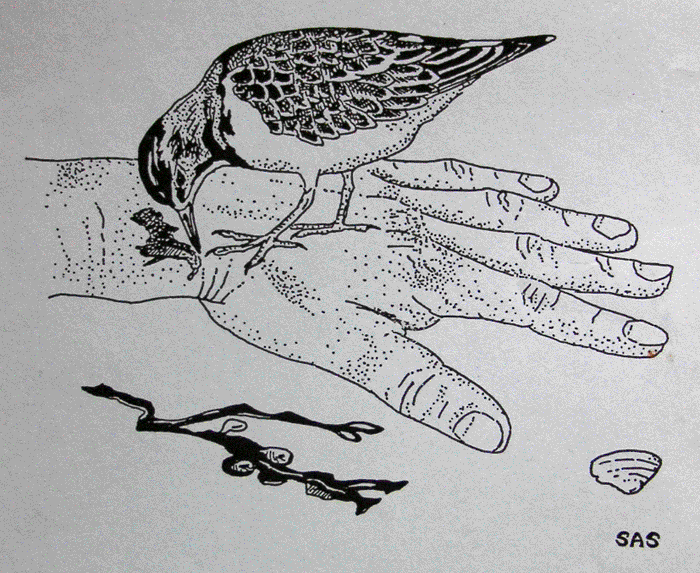
feparation of Phyllofcopuf warblerf – G. White
Suppressors – is hanging the answer?
Product report – we drive the new Porsche from Porthgwarra to Golspie
Exclusive – Mafia and Masons connected with BBRC: ex-member tells all
Editorial
Last month was one of the worst on record for rarities. As a result, we have been forced to include material on wetland bird conservation, weather effects on bird migration and on changes in status and distribution of several woodland birds. We apologise for the frequent references in this month’s issue to trash species such as Swallows, Wood Warblers and Rooks.
Next month we return to the usual diet of rarities, grippers and waxy coat tests.
Was the Blacktoft Hudsonian Godwit Hudwiticus returnicus the same individual as the Exeter bird?
Jeremy Lies, John Damnlies, and Sidney Statistics
(We publish this paper in response to letters from anxious birders wondering whether they wasted petrol money seeing the same bird twice – EDS)
The Hudwit which turned up for an extended stay in South Devon was an extremely valuable “blocking” tick for many of Britain’s twitchers. Unfortunately much of the grip-value of this occurrence was destroyed by a second record over a year later. This paper will discuss the evidence on whether the original bird was responsible for this tactless repeat performance.
Dementiev and Gladkov (1969) have nothing to say about the Hudsonian Godwit. Statistical analysis of the two British records suggests that either one or two birds were involved – a histogram of the historical occurrence of this species in Britain is given below (Fig. 1).

Figure 1. Occurrences of the Hudwit in Britain
A Pargetter twin-sampling test was performed on the above data and showed that the same bird may well have been involved (P<0.2, X2=.956 where n=2). However, a D.I.M. Witted vagrancy-potential calculation using a McLauren convergence with a Lagrange floating multiplier (assuming average wind speed 26.52 great knots/16.3 milli-pratincoles, median migration bearing 23E, 109.8W, mean binocular rating 10×50 and average British list increment 5.513 species pa) is inconclusive.
The results are thus in broad agreement with the studies of Remige & Tertial (1984) and Tarsus & Culmen (1986) on the Bitish occurrences of the Green Heron Botulinus thorngumbaldensis and the Little Whimbrel Regrippus taffiensis. (That’s enough bogus scientific bullshit – ED)
Extinct seabird relocated in British waters
Bernard Cummhoam, Alistair MacLean and Barbara Cartland
During a seawatch from Flannelborough Head on 1 March 1984, when passage included good numbers of Little Shearwaters Fratercula arctica, Cory’s Shearwaters Sula bassana, Sabine’s Gulls Rissa tridactyla and Wishful Phalaropes Calidris alba. AJC noticed a very large bird on the horizon being mobbed by Ring-billed Gulls Larus canus.
AM and BC quickly found the bird, which we estimated to be 11.63km offshore. It was soaring some 75.3-108.2m above the sea and appeared to be drifting slowly north-west, towards our observation point. BC’s tentative suggestion that the bird was a large albatross Albatrosflavur or friggingbird Frigoffa was quickly ruled out when AJC pointed out that the breadth of the wing at the carpal joint exceeded twice the wingspan of the nearby Ring-mon Gulls.
Our thoughts then turned to the possibility of the bird being a Roc, a species first described by Sinbad (124) from the Straits of Hormuz. The identification was confirmed when the bird flew down over a passing trawler and seized a deckhand in its talons. The bird then flew towards the north-east, possibly heading for the Dogger Bank (where pellets containing fragments of human bone and sou-wester were later found). It was seen to pluck at the prey, which was held in the talons, rather in the manner of a Hobby Falco amadeus. The observation period – approximately 8 mins. – allowed the following description to be taken:
Size – big. Plumage – brown. (That’s enough description for me – ED)
This appears to be the first sighting of a Roc since the time of Sinbad, and the first definite record of the species away from its previously known, rather restricted range.
Rare breeding birds in the United Kingdom in 1985
The panel, in an attempt to encourage the submission of records by those naughty recorders who withhold information on breeding grippers, has adopted a new system for the presentation of reports. County names are given, and bird names are indicated by a secrete code known only to the panel and JCVS’s wife’s best friend.
Species X1/OP
Many sites.
Loch Garten pair bred successfully in Scots Pine Pinus macpinus.
Species X1/OOQ
Not many sites.
Grimsmere ca. 70 pairs, continuing to terrorise all other avian life in the area. Wardens considering control measures to allow gulls to breed in peace.
That concludes the voting of the rare birds panel.
Product Reports
Schnitz and Snorkel 30×10
These remarkably powerful, yet easy to handle, binoculars will surely become one of the most popular binoculars amongst British birders (like it! – ED). The 30x magnification and 10mm objective lens produce some surprising views of familiar birds.
A unique quality of these binoculars is that they are equally good through either end. Any slight misgivings about the weight – 2500g – will be rapidly dispelled when one discovers their immense value as paperweights, doorstops etc. Due to the distributor having bought over 20 tonnes of stock from reputable naval suppliers, these optics are available at an amazing price. I cannot recommend them enough to those considering buying a first pair of binoculars for young birders (the cheque’s in the post – ED).
Agent Orange
Those who find birding in tropical forests troublesome need worry no more; no need to bother with tapes or CDs, and creeping about in understorey covered in leeches.
According to the manufacturers: “Take one bottle of Agent Orange into the field, remove all that bothersome foliage, take up your bins and pen and start ticking. Works in minutes, permanent results.” I tried a sample at a Black Poplar plantation in Britain. It seemed to work amazingly well, but British Rail complained at the effect on paintwork.
Though new to the UK market, extensively tested by US birders masquerading as combat troops in Vietnam. Guaranteed, no-nonsense satisfaction or your money back.
Mystery Photograph
Last month’s mystery photograph, shown here at reduced size, poses an interesting identification problem. The short legs, stumpy wings and rather stiff stance immediately suggest a game bird. Before proceeding with the identification, it is important to age the bird: the heavily abraded plumange and loss of flight feathers suggest an adult in pre-Christmas moult.
The structure and state of moult reduce the choice to one of two species – Chicken Koch adooledoo or Turkey Gobble sp. As the bird is alone it is not possible to identify the bird on size. The packet of peas in the foreground appears larger and may provide some clues, although the problem of size illusion must be borne in mind. A colour photography would show the dark pink colouration and clinch the identification as an Oven-ready Turkey G. gobblegobble. This adult was photographed in Sainsbury’s on 20 December 1985 by David Hosking.
B. MATTHEWS
Photospot
A new feature devoted to over-exposed and well photographed species.
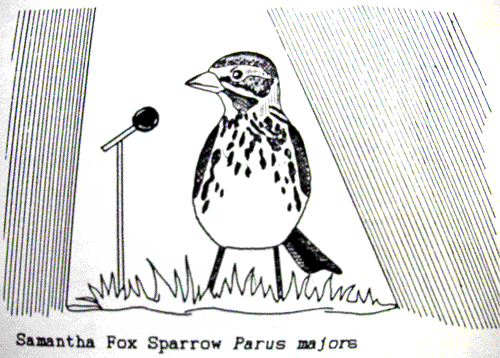
This month’s sunbird is the Samantha Fox Sparrow Pucker mountainous. This bold and well known species is readily identified by its distinctive Cockney voice. Calls include the well known “Grip me” song.
Points of View
Modern birdwatchers seem to be increasingly faced with that unpleasant dilemma – to tick or not to tick? Doubts over birds’ identities, unsatisfactory views (and in some cases no views at all) can lead to one wondering whether one is justified in claiming to have got a species on one’s list. Having pondered this problem for some time, I believe that those who feel uncertain about adding birds to their lists may find it useful to answer the following points:
Were other observers present at the time of the “observation”? If not, what’s the problem?
What is the value of the bird? Obviously, if it’s a real gripper there won’t be many more so you mustn’t be too fussy about whether you saw it well.
In cases where it’s still impossible to decide, I suggest that one wear a blindfold and make a number of marks on a copy of the Not BB list. If a mark is made near the species in question, then that’s it – another lifer! (In extreme cases, one may omit the blindfold).
J.C.B. GELDOCK
Notes
Unusual feeding behaviour of Turnstones On 12 January I was watching a party of Turnstones near Llandethly and was surprised to observe that the birds were feeding on chironomid larvae, gammarids and isopods, which they found by turning over small stones. I can find no reference to such behaviour in the literature: the only previously recorded food items being bars of soap, faeces, contraceptives, tideline corpses and vomit.
Letters
Sir,
A rather unpleasant incident at the weekend, witnessed whilst my wife and I were on our annual visit to Grimsmere, has prompted me to put pen to paper with regard to the current deplorable status of British birdwatching. Having experienced great difficulty in parking near to the reserve, due to the great number of vehicles which lined the tracks nearby, and queued for over 25 mins before entering a hide that was filled to capacity, we were treated to the following unedifying spectacle.
A young man (I shall not call him a birdwatcher) was walking into a reedbed some 50 yards in front of us, apparently expecting to locate a Schrenk’s Bittern ix eurythmics which, we were told, was hiding in the reedbed. Oblivious to the protests of many birdwatchers around the reserve, he paused and threw a large stone into the reeds before continuing.
At this juncture I noticed a large man striding along the edge of the reeds towards the miscreant. To cheers from the people beside me, the newcomer picked up the young man, carried him to the edge of a pool and thrust his head repeatedly into the muddy water.
Horrific incidents such as this, which I gather are now commonplace at birdwatching areas, detract immeasurably from the pleasure one gains from this wonderfully therapeutic hobby (my wife and I are now in our 60’s and believe our personal lives to have benefited greatly from our Sunday afternoon outings).
Surely the time has come for all decent birdwatchers to speak out against the tide of indecent and ugly behaviour which threatens to irreparably damage the standing of the hobby and for this journal to condemn the antics of those delinquents (I believe they call themselves twitchers) who do so much to undermine the good work of the RSVP, Tony Ropey, Blue Peter and Johnny Morris.
C.J. BAGGDEM-TWELVEBORE
Sir,
I first heard “Cucconiformes of the World”, by G. Belchwell, on 2 January. Is this a record?
NORA BATTY
Dear Dr Blarney-Stone,
I was once a fairly normal birder. I worked my home patch, twitched grippers alll round the country and bummed my way around a few foreign areas. Recently, all that has changed. Old friends no longer phone me with the news and people get up and leave when I enter hides or, worse, sit smirking saying “Oh yeah” when I tell them what I’ve seen.
The change began a few years ago when I fisrt became gripped (hoho, nice pun – ED) with a strange desire to ring people up and tell them about rare birds I’d seen when I actually hadn’t seen anything. Now my name’s a byword for doubtful records, but I just can’t seem to stop. Every time I see a phone I start to shake and think about Sibe Blue Robins, Pallas’s Groppers, Marmora’s. It’s just terrible. Please tell me what I can do to stop, and I’ll tell you where to go for the Sharptail I’ve just seen.
NAME AND ADDRESS SUPPLIED
A doctor writes As a doctor I am frequently asked, “Can a Herman and Royce telescope be used for birdwatching?” Although suitable for toning up arm muscles, I would like to take this opportunity to dispel the myth that this instrument has beneficial optical properties. The clarity of this scope is usually compared favourably with that of a beer bottle; in poor light often with a full one.
Great Bird Bores
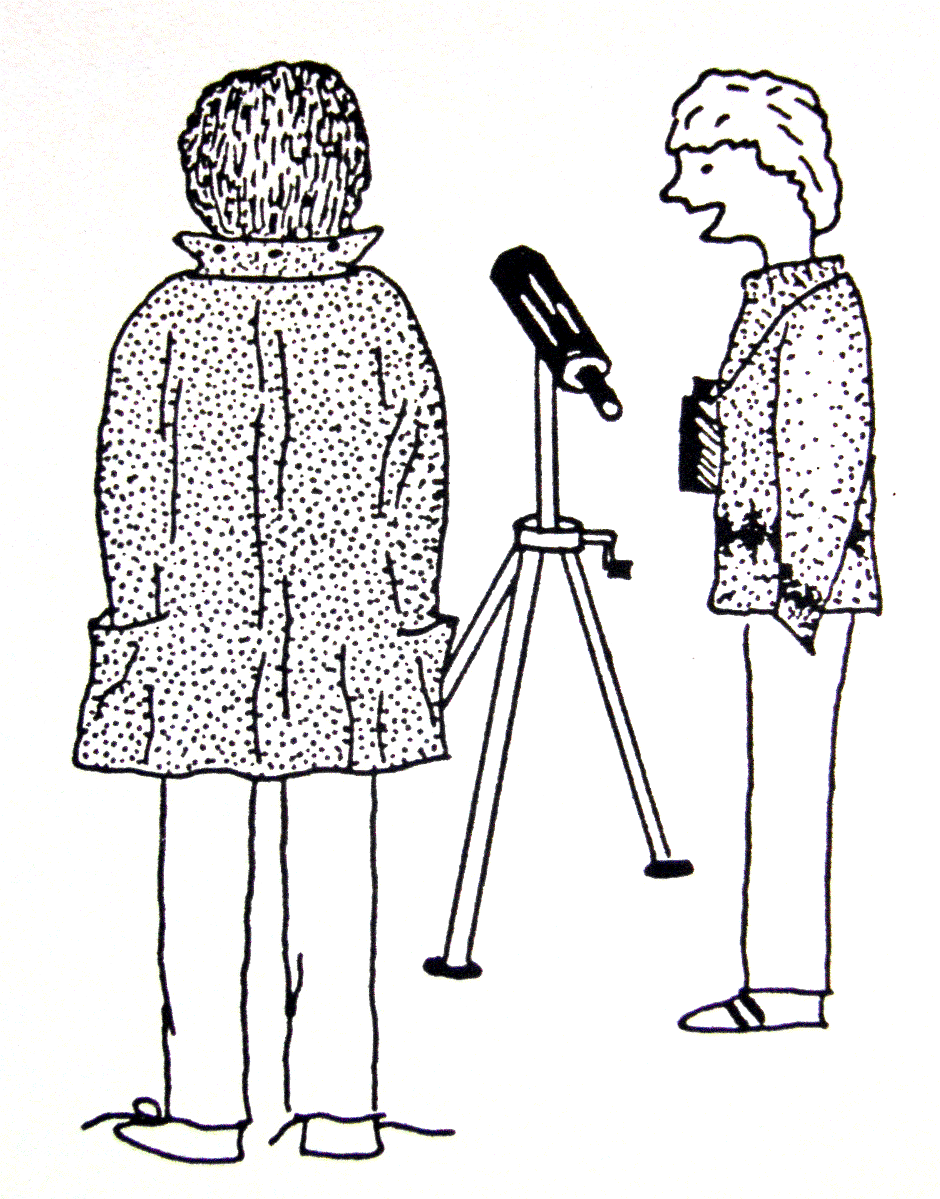
… and it was really showing well when we got here of course it wasn’t a tick and I saw lots in the States last year so it ended up more of a social event Steve’s here hadn’t seen him since the Sora he’s just returned from Morocco they really cleaned up got Marsh Owl no trouble and he was saying what a terrible spring it’s been in Kent and Dunge has had nothing the autumn should be better haven’t had a tick for ages I’m on 258 but I’m not listing this year booked in on Scilly for the second week as usual couldn’t miss it after all the big ones fell last year had Myrtle and Parula in an hour crippling views by the Pottery had them singing and in brilliant plumage at Pelee can’t stand the crowds though I’ve heard Lundy is good Tim is off to Fair Isle hoping for Petchora did you get last month’s photo I thought it was a second-winter …
Bird names explained
Woodcock
(that’s enough bird names explained – ED)
Reviews
Birds from your Armchair by Robert McDougall, Homepride, Watford, 669 pages. Hardback,

